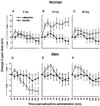Sex-based differences in pain perception and treatment
- PMID: 19207233
- PMCID: PMC2745644
- DOI: 10.1111/j.1526-4637.2008.00558.x
Sex-based differences in pain perception and treatment
Abstract
Objective: This review highlights research on sex-based differences in pain perception and treatment. We sought to illuminate the complex factors contributing to differences in pain and analgesic responses between males and females, ranging from psychosocial to biological processes.
Design: We reviewed published studies of pain induction by chemical, electric, heat, surgical, or psychological means, and opioid and nonopioid analgesia comparing responses in men and women.
Results: A substantial body of research indicates that women experience greater clinical pain, suffer greater pain-related distress, and show heightened sensitivity to experimentally induced pain compared with men. Research on sex-based differences in the pain experience and treatment is beginning to uncover patterns that may enable tailoring of pain treatment to individual characteristics. The factors underpinning sex differences in the experience of pain are multifactorial and complex; for example, psychosocial factors such as pain-related catastrophizing may explain sex-based differences in reporting certain types of pain, as women tend to use catastrophizing to a greater degree. Gonadal hormone levels in cycling women also have a substantial impact on pain perception and analgesic response. Women perceive more pain during the luteal phase, and estrogen antagonists provide long-term pain relief in certain situations.
Conclusions: Collectively, greater understanding of the factors that commonly and differentially affect the disparity in pain perception, as well as analgesic response, are beginning to illuminate research targets and promising areas of therapeutic intervention for improved pain management.
Figures
Comment in
-
Neurogenetics can help turn pain concepts more objective.Pain Med. 2009 Sep;10(6):1147-8; author reply 1148-9. doi: 10.1111/j.1526-4637.2009.00689.x. Epub 2009 Sep 9. Pain Med. 2009. PMID: 19744213 No abstract available.
References
-
- Turner JA, Franklin G, Heagerty PJ, et al. The association between pain and disability. Pain. 2004;112(3):307–314. - PubMed
-
- Juurlink DN, Herrmann N, Szalai JP, Kopp A, Redelmeier DA. Medical illness and the risk of suicide in the elderly. Arch Intern Med. 2004;164(11):1179–1184. - PubMed
-
- Unruh AM. Gender variations in clinical pain experience. Pain. 1996;65(2–3):123–167. - PubMed
-
- National Health Survey. Use of Medications. Canberra, Australia: Australian Bureau of Statistics; 1999.
-
- Isacson D, Bingefors K. Epidemiology of analgesic use: A gender perspective. Eur J Anaesthesiol Suppl. 2002;26:5–15. - PubMed


